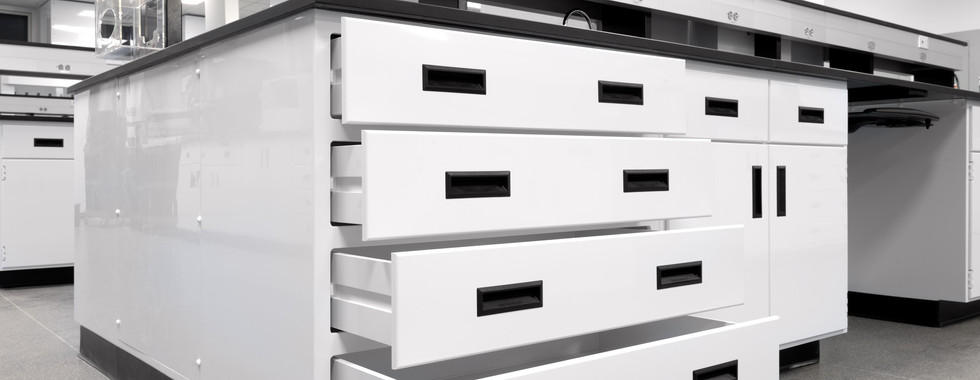
Location: Environmental Protection Commission Hillsborough County, Florida
Architect: Long & Associates
General Contractor: Walbridge
Installation Contractor: Steve Ward and Associates
Products for Laboratory: Polypropylene Casework and Fume Hoods with Flame-Retardant Liner by LabAire Systems (LAS).

Overview:
The Hillsborough County Environmental Protection Commission (EPC) laboratory services provides environmental impact testing for chemical analysis of air, water and sediment samples at local, state and federal levels. Growing demand for EPC’s contracted services at the existing Wastewater Treatment facility necessitated upgrading all laboratories in the building. The final laboratory build consisted of approximately 10,000 square feet of laboratory space including dedicated laboratory spaces for Organics, Bacteriology, Metals Prep, Heavy Metals, Solids, Dispensing, Washing, and an open laboratory for basic oxygen and carbon testing.

The Challenge:
The Hillsborough County facility conducts a wide variety of procedures including metal analysis, biochemical oxygen and total organic carbon testing. Corrosive chemicals such as acids, bases and volatile compounds are used as part of the analysis process, posing a significant health risk to laboratory technicians. Workers must be protected from harmful fumes produced by these chemicals during testing procedures. These same chemicals cause significant damage to metal fume hoods and traditional casework made of metal or wood. Because of the varying procedures and chemicals used, some rooms in the laboratory had to be separated by ventilation zones to minimize the potential for cross-contamination. The new laboratory and equipment also needed to meet certification standards of by the National Environmental Laboratory Accreditation Program for the Clean Water Act (NELAP).
LAS worked with the EPC to understand the laboratory’s protocols and to identify the chemicals used that might produce toxic fumes and vapors. Through this process LAS raised concerns about several chemicals that had combustible characteristics. As a result, LAS recommended lining all fume hood with flame-retardant materials to meet current UL and NFPA safety codes. Walbridge General Contractor Project manager, Bernie Chilton commented “LAS was selected to supply the fume hoods and casework for this project based on their ability to understand the customer’s applications and deliver on schedule.”

The Solution:
LAS proposed an open laboratory design for most of the facility that would allow researchers to collaborate in a cross-disciplinary manner. Several smaller rooms were also equipped with custom fume hood solutions for specialty procedures requiring isolation. Polypropylene was the material selected for this project because of its ability to withstand harsh chemical exposure, corrosion and high impact-resistance. The investment in polypropylene would provide a greater value long term as it eliminated the need to replace metal or wood equivalents which could rust and corrode.
The 250 pieces of polypropylene casework for this facility were fabricated from Vycom ½” white stress-relieved polypropylene featuring all polypropylene construction that included hinges, fasteners and adjusting hardware for maximum chemical resistance. Much of the casework was selected from standard sizes with several custom-designed modules for special use. Fully recessed door and drawer pulls created a streamlined aesthetic for the laboratory. Cabinets requiring transparent chemical storage were equipped with clear polycarbonate panels in the doors. Work surfaces and counter tops were fabricated from epoxy resin, an especially inert material with high chemical and corrosion-resistance.
LAS provided a combination of 14 standard and custom sized fume hoods specific for each laboratory protocol. Each fume hood was fabricated with a custom, flame-retardant liner to meet the FM4910 flammability standard. A combination of variable-air volume and constant-air volume fume hoods in the main laboratory were supplied in six or eight-foot widths. The smaller procedure rooms were equipped with four-foot fume hoods and a custom twelve-foot fume hood was designed to accommodate a sequential process in the washing room.
NFPA-compliant flammable storage cabinets for chemicals were provided in several locations within the laboratory. In addition to installed cabinets, several mobile work carts of polypropylene construction were provided.

Conclusion:
To meet the specialty needs of this laboratory, LAS worked with the client to understand their challenges which resulted in the recommendation for polypropylene casework, accessories and fume hoods that would provide years of reliable, corrosion-resistant service. Stephen Ward, of Steve Ward and Associates summed up the project “Labaire shared and exemplified our principles of forward thinking, planned execution, and effective communication through all project phases helping to get the project done on time and on budget. We’re looking forward to working with LAS on our next project.”















Comments